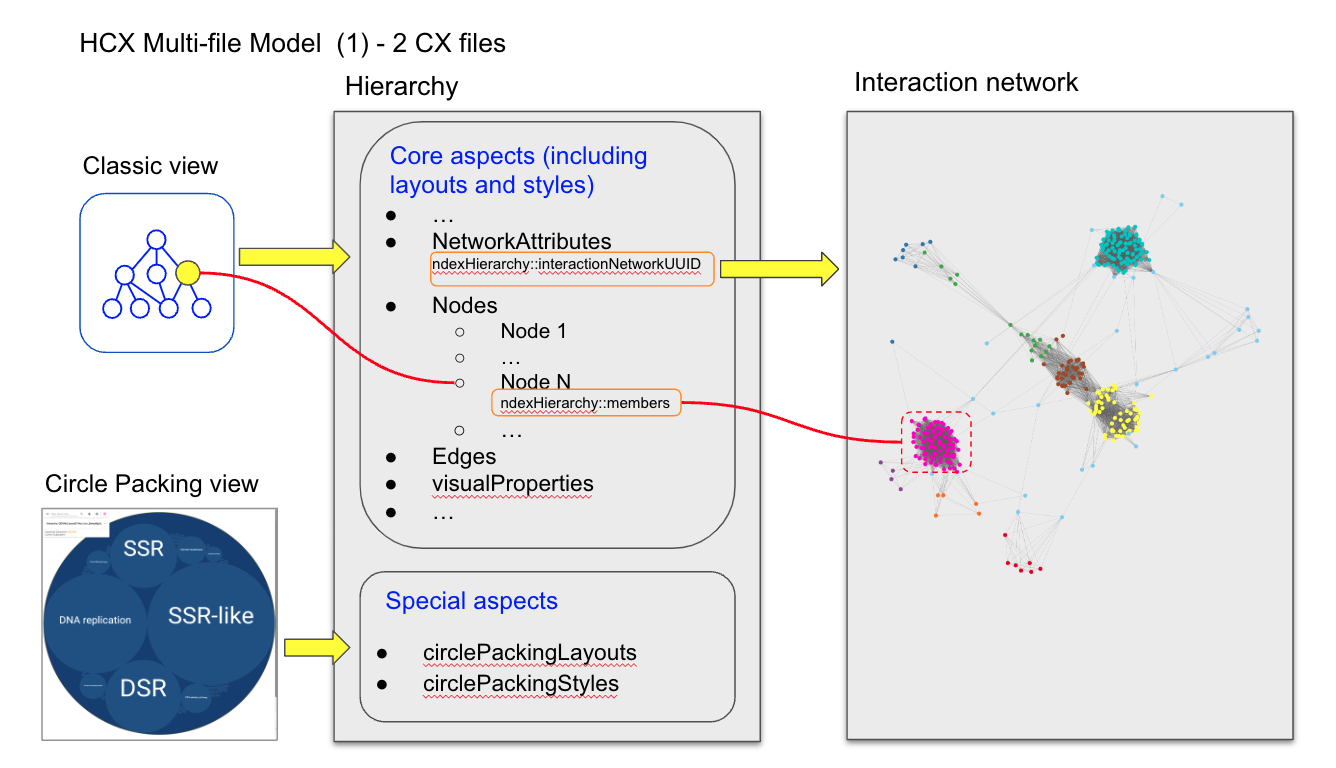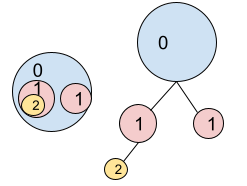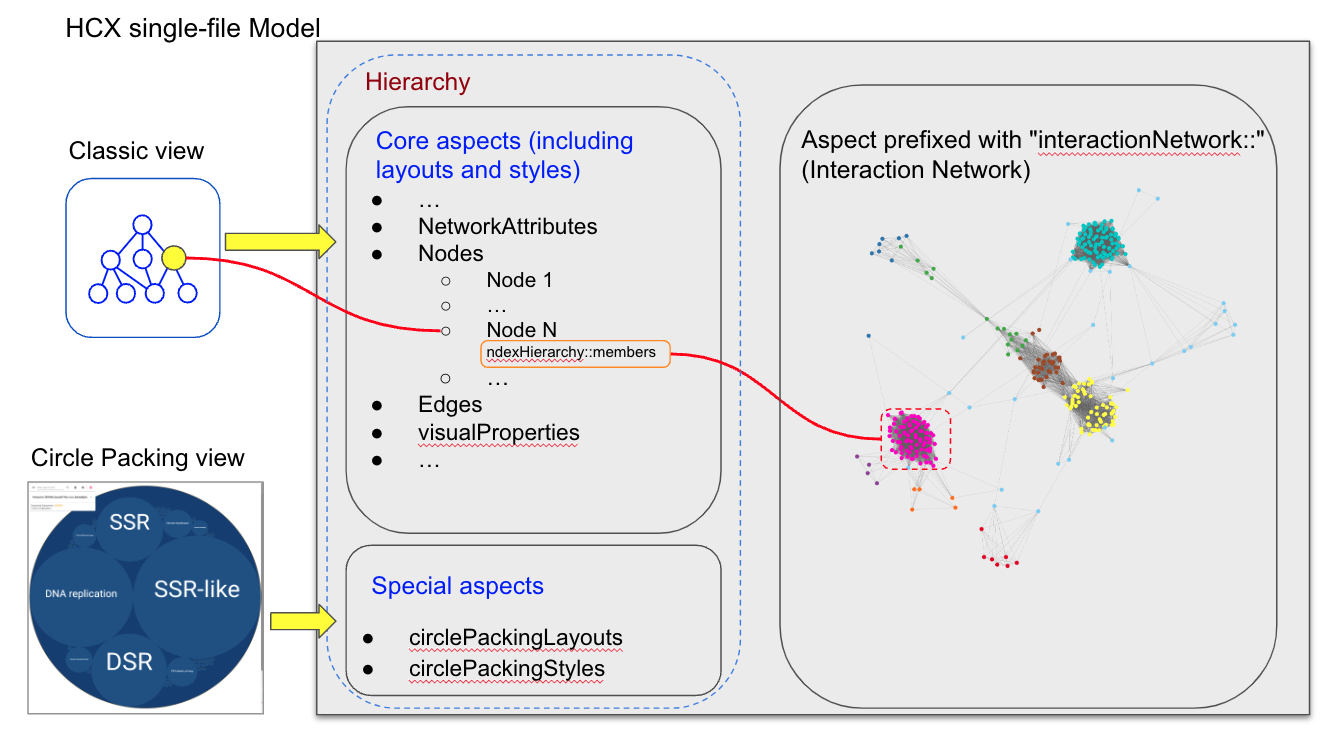Hierarchical Network Schema for CX2 (HCX) (Version 0.1)
This document outlines the CX schema designed to store hierarchical structures within a CX network. Within Ideker Lab’s applications, a hierarchy typically encompasses two distinct data categories:
- An interaction (or similarity) network.
- A hierarchy that is derived from the aforementioned interaction network.
The hierarchy and the interaction network can be stored in one or more CX files, contingent upon specific application requirements. This CX schema is designed for Cytoscape-Hiview integration, it should also cover other common use cases in Ideker Lab.
Applicable solely to CX version 2 (CX2) only, this schema accommodates two primary storage models:
- Multi-file model - In this approach, hierarchies and associated interaction network(s) reside within two or more CX files. This model aligns with our usage in Cytoscape Web.
- Single file model - This model contains only one CX file. Its major use case is for archival.
Multi-file model
In this model, the complete data set contains one network for the hierarchy, and one or more networks for the interaction networks. These networks can be stored as flat files in the file system. They can also be stored as CX networks in NDEx or a Cytoscape Web workspace.

Hierarchy network
This network stores the hierarchy derived from the interaction network, including its visual styles and layouts. In general, users can put any attributes on nodes and edges, and the network. However, this schema adds these constraints to some of the core aspects.
networkAttributes
It should contain these attributes
-
Attribute name: ndexSchema
Attribute value type: string
Attribute value: hierarchy_v0.1
-
Attribute name: HCX::modelFileCount
Attribute value type: integer
Attribute value: Should be greater than 1. It is the actual count of all the files that this hierarchy references, including the hierarchy itself. This is the value that can be used to decide the type of a model file. 1 is a single file model and all other values means this is a multi-file model.
Note: nodes on this hierarchy can point to its own interaction network. It is normally a subnetwork of the top level interaction network, but it can also be any network.
-
One of these attributes to link to the interaction network.
-
Attribute name: HCX::interactionNetworkUUID
Value: uuid of the interaction network. If the interaction network is stored on a NDEx server, this attribute should contain the uuid of that network. If the interaction network is a local network in users current Cytoscape Web workspace, this attribute contains the local uuid of that network.
-
-
Attribute name: HCX::interactionNetworkName
Value: file name as a string, assume the file is located in the same directory of the hierarchy
-
Attribute name: HCX::interactionNetworkURL
Value: a URL which points to the interaction network.
Note: If each node in the hierarchy points to its own interaction network, it is possible to omit the interaction links at the network level.
nodes
Each node in the hierarchy should have this attribute:
-
Attribute name: HCX::isRoot
Attribute value type: boolean
Attribute value: Root node should have value true and all other nodes should have false on this attribute.
A node in the hierarchy can link to a subnetwork in the parent interaction network or a separate network. The linkage can be established using one of these attributes on a node in the hierarchy.
-
Attribute name: HCX::members
Attribute value type: list of long
Attribute value: list of CX IDs of nodes in the interaction network. It is similar to the CD_memberList attribute in the hierarchy network generated by the CDAPS app in Cytoscape.
-
Attribute name: HCX::memberEdges
Attribute value type: list of long
Attribute value: list of CX IDs of edges in the interaction network.
-
Attribute name: HCX::interactionNetworkUUID, HCX::interactionNetworkName or HCX::interactionNetworkURL
Attribute value type: string
Attribute value: Using one of these attributes, a node can declare its own interaction network. When one of these attributes exists, it overwrites the value declared in the networkAttributes aspect.
-
Attribute name: HCX::memberNames
type: list of string
Description: Hiview uses this value to label each member node in the circle-packing layout. Each element in this list needs to be unique. Typically, each value in this list is the gene symbol of a member within a subsystem. However, users have the flexibility to assign alternative identifiers to this attribute. If this attribute is absent, Hiview will default to using the name attribute of the nodes specified in the HCX::members attribute for the node label. If neither HCX::members nor HCX::memberNames is defined for at least one node, the circle-packing layout option will be deactivated in Hiview. If both HCX::members and HCX::memberNames exist on a node, Hiview uses HCX::members.
-
Attribute name: HCX::memberQuery
Attribute value type: string
Attribute value: a JSON string which describes a query on the interaction network. It has this structure:
{ "nodes": { "attribute": string // name of the attribute "values": list of values }, "edges": { "attribute": string "operator": string // supported values are ">", "=", "<" or "in" "value": single value or a list of values } }For example: this JSON structure
{ "nodes": { "attribute": "name", "values": ["AKT1", "MTOR","EGFR" ] } "edges": { "Attribute":"score", "operator": ">", "value": 0.6 } }means this node links to a subnetwork derived from a direct query starting from nodes which have “AKT1”,”MTOR” or “EGFR” on its name,and the edges with score value above 0.6 between the starting nodes.
edges
Edges are directed. In the majority of our hierarchical networks, we adhere to the convention of designating the child node as the target node for each edge. However, users can opt to reverse the edge direction if it aligns more effectively with their use case.
Visualization of the hierarchy
The core aspects store the ball-and-stick (classic) view of the hierarchy, which includes a layout and one or many visual styles.
The default visual style for the classic view is stored in the visualProperties aspect. If the classic view has more than one style defined on it, these additional styles should be named and they should be stored in the otherVisualProperties aspect. This is the structure of the otherVisualProperties aspect:
{
otherVisualProperties: [
{
"name": string // name of the style
"visualProperties": [
//Visual properties and mapping rules defined in the style.
]
}
]
}
Visualization data for circle-packing (Hiview) view are stored in these two aspects
-
circlePackingLayouts: This aspect contains the layout information for Hiview. It has this data structure:
{ circlePackingLayouts: [ { "id": string // unique id "cxId": //CX Id of node this circle represents "X": number // x coordinate of the circle "Y": number // y coordinate of the circle "R": number // radius of the circle "depth": integer // steps to the root node. It should be a non-negative integer. "type": gene or assembly // } ] }For circle packing Depth is 0 for root node (blue) as seen in this figure

-
circlePackingStyles:
{
visualProperties and mappings
}
Interaction network
There is no special requirements for the interaction network(s) in the multi-file model.
Single-file model
In this model, a hierarchy and its interaction network are stored in a single CX network. The hierarchy is stored in the core aspects, such as “nodes” and “edges” aspects, and interaction network data are stored in opaque aspects prefixed with “interactionNetwork::” in the aspect name.

Constraints on core CX aspects
In general, users can put any attributes on nodes and edges, and the network. However, this schema adds these constraints to some of the core aspects.
networkAttributes
It should contain these 2 attributes
-
Attribute name: ndexSchema
Attribute value type: string
Attribute value: hierarchy_v0.1
-
Attribute name: HCX::modelFileCount
Attribute value type: integer
Attribute value: 1
Nodes
All specifications regarding node attributes in the multi-file model apply to the nodes in the single-file model, with the exception that the HCX::interactionNetworkUUID, HCX::interactionNetworkName, and HCX::interactionNetworkURL attributes are not supported.
Interaction network
The data of the interaction network are stored in aspects that are prefixed with “interactionNetwork::”. For example
interactionNetwsork::attributeDeclarations aspect stores the attributeDeclarations aspect of the interaction network, and interactionNetwork::nodes aspect stores the nodes aspect of the interaction network. The interaction network can contain any number of styles on it using the scheme we detailed in the “Visualization of the hierarchy” section. The only difference is that these aspects need to be prefixed with “interactionNetwork::” in the single file model.